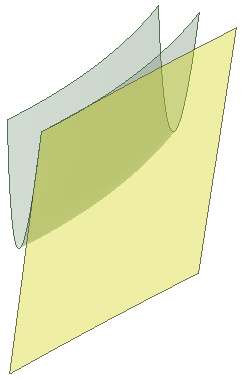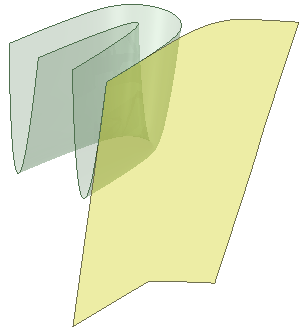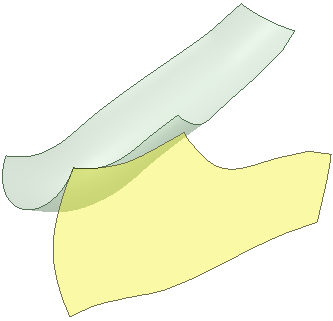Double Curvature Surfaces
Doubly curved surfaces (for example, spherical, toroidal, etc.) are unrolled approximately into flat sheets.
Unrolling a doubly curved surface introduces some distortion in angles and/or lengths
Doubly curved surfaces that have small curvature in one of the directions will unroll
- A sphere would distort too much to flatten (picture a flattened map of the world)
- A big enough torus, and many free-form designs can be flattened without too much distortion
Angles, perimeter, and area are preserved as closely as possible (within 15%)
- The accuracy increases as the curvature decreases
- The simpler the shape, the more accurate the perimeter and area
This example is a parabola swept along a slightly curved trajectory. Notice that the Area and Perimeter are both within 0.3% of the original.
| Original Surface Properties |

|

|
|
Unrolled Surface Properties Area within 0.3% Perimeter within 0.2% |

|
This example is a parabola swept along a highly curved trajectory. Notice that the Area and Perimeter are also both within 0.3% of the original. This is because the shape is a simple parabola.
| Original Surface Properties |

|

|
|
Unrolled Surface Properties Area within 0.3% Perimeter within 0.2% |

|
This example Is a more organic shape. Notice that the Area is within 0.4% and the Perimeter is within 6.5%.
| Original Surface Properties |

|

|
|
Unrolled Surface Properties Area within 0.3% Perimeter within 0.2% |

|
This example is a more complex perimeter. Notice that the Area is within 0.8% and the Perimeter is within 6.0%.
| Original Surface Properties |

|

|
|
Unrolled Surface Properties Area within 0.3% Perimeter within 0.2% |

|


